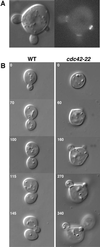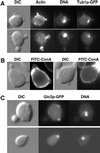Singularity in budding: a role for the evolutionarily conserved small GTPase Cdc42p
- PMID: 12218170
- PMCID: PMC129419
- DOI: 10.1073/pnas.182370299
Singularity in budding: a role for the evolutionarily conserved small GTPase Cdc42p
Abstract
The budding yeast Saccharomyces cerevisiae initiates polarized growth or budding once per cell cycle at a specific time of the cell cycle and at a specific location on the cell surface. Little is known about the molecular nature of the temporal and spatial regulatory mechanisms. It is also unclear what factors, if any, among the numerous proteins required to make a bud are involved in the determination of budding frequency. Here we describe a class of cdc42 mutants that produce multiple buds at random locations on the cell surface within one nuclear cycle. The critical mutation responsible for this phenotype affects amino acid residue 60, which is located in a domain required for GTP binding and hydrolysis. This mutation bypasses the requirement for the essential guanine-nucleotide-exchange factor Cdc24p, suggesting that the alteration at residue 60 makes Cdc42p hyperactive, which was confirmed biochemically. This result also suggests that the only essential function of Cdc24p is to activate Cdc42p. Together, these data suggest that the temporal and spatial regulation of polarized growth converges at the level of Cdc42p and that the activity of Cdc42p determines the budding frequency.
Figures






Similar articles
-
Identification of novel, evolutionarily conserved Cdc42p-interacting proteins and of redundant pathways linking Cdc24p and Cdc42p to actin polarization in yeast.Mol Biol Cell. 2000 Feb;11(2):773-93. doi: 10.1091/mbc.11.2.773. Mol Biol Cell. 2000. PMID: 10679030 Free PMC article.
-
Saccharomyces cerevisiae cdc42p GTPase is involved in preventing the recurrence of bud emergence during the cell cycle.Mol Cell Biol. 2000 Nov;20(22):8548-59. doi: 10.1128/MCB.20.22.8548-8559.2000. Mol Cell Biol. 2000. PMID: 11046150 Free PMC article.
-
The upstream regulator, Rsr1p, and downstream effectors, Gic1p and Gic2p, of the Cdc42p small GTPase coordinately regulate initiation of budding in Saccharomyces cerevisiae.Genes Cells. 2003 Mar;8(3):235-50. doi: 10.1046/j.1365-2443.2003.00629.x. Genes Cells. 2003. PMID: 12622721
-
Cdc42: An essential Rho-type GTPase controlling eukaryotic cell polarity.Microbiol Mol Biol Rev. 1999 Mar;63(1):54-105. doi: 10.1128/MMBR.63.1.54-105.1999. Microbiol Mol Biol Rev. 1999. PMID: 10066831 Free PMC article. Review.
-
Cdc42p, GTP hydrolysis, and the cell's sense of direction.Cell Cycle. 2004 Jul;3(7):861-4. Epub 2004 Jul 26. Cell Cycle. 2004. PMID: 15190213 Review.
Cited by
-
Role of combined cell membrane and wall mechanical properties regulated by polarity signals in cell budding.Phys Biol. 2020 Oct 21;17(6):065011. doi: 10.1088/1478-3975/abb208. Phys Biol. 2020. PMID: 33085651 Free PMC article.
-
Regulation of the Cdc42/Cdc24 GTPase module during Candida albicans hyphal growth.Eukaryot Cell. 2005 Mar;4(3):588-603. doi: 10.1128/EC.4.3.588-603.2005. Eukaryot Cell. 2005. PMID: 15755921 Free PMC article.
-
Secretory vesicles deliver Cdc42p to sites of polarized growth in S. cerevisiae.PLoS One. 2014 Jun 19;9(6):e99494. doi: 10.1371/journal.pone.0099494. eCollection 2014. PLoS One. 2014. PMID: 24945395 Free PMC article.
-
Cell cycle entry triggers a switch between two modes of Cdc42 activation during yeast polarization.Elife. 2017 Jul 6;6:e26722. doi: 10.7554/eLife.26722. Elife. 2017. PMID: 28682236 Free PMC article.
-
Spontaneous Cdc42 polarization independent of GDI-mediated extraction and actin-based trafficking.PLoS Biol. 2015 Apr 2;13(4):e1002097. doi: 10.1371/journal.pbio.1002097. eCollection 2015 Apr. PLoS Biol. 2015. PMID: 25837586 Free PMC article.
References
-
- Pruyne D. & Bretscher, A. (2000) J. Cell Sci. 113, 365-375. - PubMed
-
- Pruyne D. & Bretscher, A. (2000) J. Cell Sci. 113, 571-585. - PubMed
-
- Pringle J. R., Bi, E., Harkins, H. A., Zahner, J. E., De Virgilio, C., Chant, J., Corrado, K. & Fares, H. (1995) Cold Spring Harbor Symp. Quant. Biol. 60, 729-744. - PubMed
-
- Chant J. (1999) Annu. Rev. Cell Dev. Biol. 15, 365-391. - PubMed
-
- Cvrckova F., De Virgilio, C., Manser, E., Pringle, J. R. & Nasmyth, K. (1995) Genes Dev. 9, 1817-1830. - PubMed
Publication types
MeSH terms
Substances
Grants and funding
LinkOut - more resources
Full Text Sources
Molecular Biology Databases
Miscellaneous

